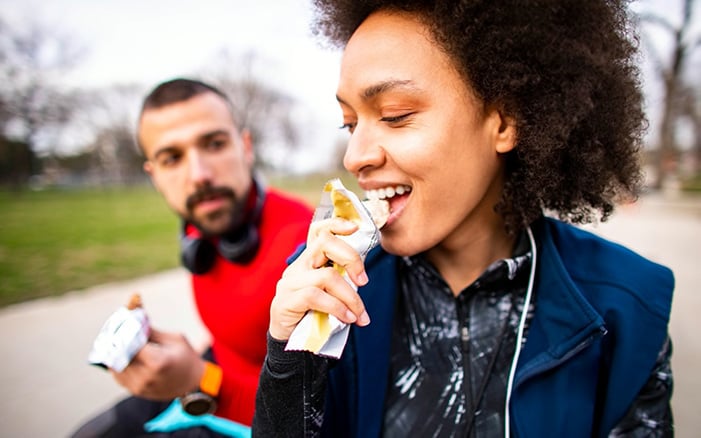They look healthy. They sound healthy. Some even show up in pro athlete meal photos. But for everyday runners some “clean” or performance-marketed foods can do more harm than good. And while there’s no single perfect diet, these foods are more likely to leave you feeling sluggish, bloated, or underpowered—especially around runs.
Here’s what to watch out for—and what to eat instead to stay strong and energized before, during, and after your runs.

1. High-fiber cereals
Whole-grain, fiber-packed cereals seem like a smart start to the day—and for general health, they often are. But as a pre-run food, they’re a recipe for GI trouble.
That fiber takes longer to digest and can cause bloating, gas, and an urgent mid-run bathroom stop. Some brands also sneak in extra sweeteners and dried fruit, which can be tough on the stomach before activity.
A better choice: You can still enjoy high-fiber cereal—just three or more hours before your run, so your body has time to digest it. If you’re eating closer to start time, go for something easier on your stomach:
- A small bowl of instant oats (low in fiber, quick to digest, and a steady source of carbs)
- White toast with nut butter and banana (simple carbs + healthy fat + potassium for muscle function)
These combos provide quick energy without weighing you down or upsetting your stomach.
2. Energy granola
Granola often seems like cereal’s cool cousin. It’s marketed with running vibes and energy-boosting claims. But nutritionally, it’s not always run-friendly—especially in large portions.
Like high-fiber cereal, granola can be hard to digest before a run. It’s also calorie-dense, often loaded with added sugar, oils, and dried fruit. Even the “healthy” ones can turn a snack into a sugar bomb.
A better choice: Use a small amount of granola as a topping (not a full bowl) with Greek yogurt or cottage cheese, and pair it with fruit for balance.
Related: 8 Eating Habits That Kill Your Running Weight Loss Goals
3. Gluten-free products
Unless you have celiac disease or a diagnosed gluten intolerance, “gluten-free” doesn’t mean better. Many gluten-free crackers, bars, and breads are heavily processed, low in fiber and protein, and high in starches that spike your blood sugar without lasting energy.
Plus, cutting gluten without a clear reason can reduce your intake of complex carbs and key nutrients like B vitamins and iron—things runners actually need more of.
A better choice: Stick with whole, minimally processed carbs like brown rice, whole-grain bread, or quinoa—unless your body truly does better without gluten.
4. Protein bars
They’re everywhere: at the gym, the checkout line, even the aid station table. But many protein bars are more like candy bars in disguise—filled with sugar alcohols, artificial flavors, and fiber blends that can leave you bloated or cramping mid-run.
While protein is crucial for recovery, eating a bar right before a workout can slow digestion and weigh you down—especially if it’s high in fat.
A better choice: Save protein bars for post-run recovery (ideally within 30–60 minutes), when your muscles actually need that protein boost. Look for options with 10–20 grams of protein and some carbs for glycogen replenishment.
They also work as a convenient snack between meals or on the go—just not as pre-run fuel.
5. Flavored yogurt cups
Yogurt is often viewed as a high-protein, gut-friendly snack. But flavored versions—especially fruit-on-the-bottom or low-fat styles—tend to be high in added sugars and low in actual protein.
They may leave you feeling hungry again in an hour, or spike your energy and crash it before a run. Some also contain thickeners or stabilizers that don’t sit well mid-run.
A better choice: Choose plain Greek yogurt, add real fruit, a drizzle of honey, and maybe a sprinkle of nuts for energy.
6. Coconut water
It’s trendy, natural, and often marketed as a “clean” sports drink. But for most runners, especially in hot weather or during long runs, coconut water doesn’t cut it.
It contains potassium—but not nearly enough sodium, which is the key electrolyte lost in sweat. It also lacks carbs for mid-run fueling and can cause bloating or nausea if over-consumed.
A better choice: For sweaty workouts or longer runs, opt for electrolyte drinks with higher sodium content—like LMNT Electrolyte, Redmond Re-Lyte, or Liquid I.V. These are designed to replace what you lose in sweat.
Save coconut water for casual sipping, not for hard efforts or race-day hydration.
7. Fruit smoothies
Smoothies have a health halo: they’re colorful, packed with fruit, and feel like an easy way to load up on vitamins. But many fruit-based smoothies—especially bottled or juice bar versions—are extremely high in sugar and low in the protein or fat that helps keep your energy steady.
Even homemade ones can sneak in a lot of natural sugars from bananas, mangoes, dates, and fruit juice, sometimes racking up over 40 grams of sugar—that’s about 10 teaspoons—in a 16-ounce glass. That can cause a quick energy spike followed by a crash, especially if you drink it too close to a run.
A better choice: If you love smoothies, build one with balance in mind: include a protein source (like protein powder), one fruit (not five), and avoid fruit juice as the base. Keep the portion moderate, and save it for after your run, when your body is ready to absorb the carbs.
Related: 10 Foods and Drinks to Avoid Before Your Run
Just because something is marketed as healthy doesn’t mean it’s good for runners. Plenty of products look great on shelves or in influencer posts—but fall short when it’s time to fuel real training.
Runners need energy that digests well, protein that helps you recover, and hydration that actually replaces what you lose. Skip the hype, trust what works for your body, and focus on whole, familiar foods whenever possible.









